The March 7 Show – Hauppauge, Long Island
The 2015 Annual Show of the Long Island Decoy Collectors Association Show was a great success – and exceeded our expectations. Lots of new faces – and we sold out our “first run” of DVDs. We have already printed 2 more batches and they are available from me – although all proceeds go to the Decoy Association.
To order:
1. Send me a PERSONAL CHECK made out to STEVE SANFORD – with LIDCA-DVD on the memo line
Steve Sanford
PENCIL BROOK FARM
160 Gannon Road
Buskirk, NY 12028
2. Price is $20 for first copy and $10 more for each additional copy (includes shipping).
3. Be sure to provide YOUR RETURN ADDRESS.
Here is a Broadbill’s eye view of the exhibit.
The big bay chart with almost 50 known rigs – from 1935 through 1985 – was the centerpiece. The were over 50 decoys from the era and the 2 monitors showed the documentary film and the vintages photos all day long.
Although most of the crowd was from the Greybeard demographic, there were a few “future gunners”…..
Here is the gift we gave to each of our “movie stars” – framed, of course!
Here is four-fifth of the cast – we never could get everybody in one shot. From L to R are Schuyler Watts, John Verbeke, Preston Raynor and Allen Horal. I think Dick LaFountain was standing behind Craig or me.
This watercolor was an “also ran” for the gift. Someday, I will paint another version with the bird’s wings a little stiffer and backswept…..
Here is the Broadbill I carved for Anthony Babich, our videographer. Anthony was studying for final exams at the University of Maryland – so his Dad Mike accepted our gift – signed on the bottom by the whole Broadbill team.
Each decoy or pair had a card identifying the maker (if known) and rig owner. They all had the same image – of the Wildfowler Battery Model drake Broadbill.
And here are some shots from the Show – click on any one to start the Slide Show format.
Gallery 1
Here is the Press Release:
Long Island Decoy Collectors Association Annual Show
CONTACTS:
Craig Kessler ckesslerducks@gmail.com 516-639-8480
Steve Sanford sjaysanford@gmail.com 518-677-5064
THEME: WHEN the BROADBILL was KING on GREAT SOUTH BAY
DATE: Saturday, March 7, 2015
LOCATION: IBEW Hall #25, 370 Motor Parkway, Hauppauge, LI, NY
INFORMATION: www.lidecoycollectors.org
The history of market hunting for waterfowl has been told many times. What has yet to be told, however, is the era that followed the demise of market hunting and its deadliest “tools” – the batteries and sinkboxes that were finally banned in the mid-1930s. For the next half-century, though, Long Island’s Great South Bay still held hundreds of thousands of Broadbill (aka Greater Scaup) each fall and winter. And the many guides – who had first hunted for the market and then later “took out parties” of sportsmen and women – still hunted this grand bird. Their big broadbill rigs had a large cabin boat to serve as the tender, often an open stool boat to carry and handle just the decoys, and a “scooter” to replace the battery as the open water blind. Gunners stayed warm on the tender – often around a stove with a hot mug of coffee or stew – and watched the rig while awaiting their turn in the scooter. This year’s Show will celebrate this exceptional era in American waterfowling – which many Long Islanders can still recall from firsthand experience.
Since last spring, retired Ducks Unlimited Director Craig Kessler and former NYSDEC Waterfowl Biologist Steve Sanford have been leading a team of veteran duck hunters from Great South Bay. Together, they have been collecting stories, photographs, decoys, gear and even boats. The special exhibit will showcase many of the rigs from the wide open parts of Great South Bay – from Patchogue in the east to Babylon in the west. We hope this exhibit will attract and inform waterfowlers from all over – and Long Islanders from all walks of life. Anyone interested in local families, maritime history, folk art and bay ecology will find something to learn and enjoy. And, when not admiring the thousands of antique decoys and other collectibles throughout the Show, everyone can enjoy hot foods available from the landscape of Long Island and Great South Bay.
The Documentary – When the Broadbill was King on Great South Bay
In addition to decoys from each rig, the Decoy Collectors display will include a couple of boats – one an original Dodge & Krowl “whaleback”, big screens with hundreds of vintage photographs and an 87-minute documentary film. The documentary tells the story through period photographs, in-depth interviews with several veteran gunners, and a contemporary Broadbill shoot done in the ways of this era. It film will appeal to anyone interested in waterfowl, duck shooting, vintage boats, bay ecology, and Long Island history and culture. Broadbill is co-hosted by Ducks Unlimited Regional Director Craig Kessler (retired) and NYSDEC Chief Ecologist Steve Sanford (retired). The filming and editing are by Anthony Babich (www.island-outdoors.com). You can view a teaser for When the Broadbill was King on Great South Bay at: https://vimeo.com/116558936 and copies of the DVD – with both the documentary and the slide show will be available – $10 at the show and $20 later on by mail. All proceeds from the DVD sales go to the not-for-profit Long Island Decoy Collectors Association.
And here are some stills from the Exhibit and Slide Show.
Gallery 2 – click on any photo to start the slide show mode
Narratives from the Exhibit
The centerpiece of the exhibit was an enlarged Bay Chart on which we located almost 50 known rigs. In addition, though, we had narratives about this period as well as features on individual rigs. Here is the Chart – then the narratives:
Gallery 3 – click on any photo to start slide show mode
WHEN the BROADBILL was KING on GREAT SOUTH BAY
The history of market hunting for waterfowl has been told many times. What has yet to be told, however, is the story of the era that followed the demise of market hunting and its deadliest “tools” – the batteries and sinkboxes that were finally banned in the mid-1930s. For the next half-century, though, Great South Bay still held hundreds of thousands of Broadbill (aka Greater Scaup) each fall and winter. And the many guides – who had first hunted for the market and then later “took out parties” of sportsmen and women – still hunted this grand bird. Their big Broadbill rigs had a large cabin boat to serve as the tender, often an open stool boat to carry and handle just the decoys, and a “scooter” replaced the battery or sinkbox as the open water blind. Gunners stayed warm on the tender – often around a stove with a hot mug of coffee or stew – and watched the rig while awaiting their turn in the scooter. This exhibit celebrates this exceptional era in American waterfowling – which many Long Islanders can still recall from firsthand experience.
We have gathered together lots of information over the past year – but we welcome any new information – about gunners, boats, decoys, gear – and especially photographs from the period. We even welcome corrections. Please talk with Craig Kessler or Steve Sanford.
GREAT SOUTH BAY before 1935
Waterfowl have probably been hunted on Great South Bay since there was a Great South Bay after the last glaciation created Long Island about 14 thousand years ago. The long shallow lagoon was fed by scores of freshwater creeks and many inlets to the Atlantic came and went over the centuries.

In 1629, the West India Company issued hunting permits to residents of the New Netherlands. The battery – which was probably “invented” on Great South Bay – was banned by New York State in 1838 – but the ban was ignored by market hunters.
In 1886, spring shooting was banned by New York – except for Brant.
The first season – 212 days long – was set in 1899 and ran from October 1 through April 30.
The first bag limit was set in 1912 – 25 Ducks per day – but no more than 40 per blind, boat or battery.
Market hunting was banned in 1918 under the Migratrory Bird Treaty Act. Many market hunters guided “sports” with the same battery rigs.
As the droughts of the Dust Bowl hurt waterfowl breeding, the 1930 bag limit was reduced to 15 Ducks + 4 Geese or Brant.
By 1934, the season was open only on Thursdays, Fridays and Saturdays – for a total of 30 days – from October 25 through December 9. Duck Stamps were required for the first time – to purchase waterfowl habitat.
The battery was finally banned by federal law in 1935. The season ran from October 21 through November 19 (30 days). The daily bag limit was 10 Ducks + 4 Geese .
BROADBILL BIOLOGY
Broadbill is the name that Long Island gunners have long used for the Greater Scaup. They are known as Bluebills in many other parts of the country – Blackhead is a name from the Chesapeake.
The Broadbill is a member of the duck tribe known as Pochards – medium-sized diving ducks with round bodies. They are often known as “bay ducks” because of their preference for shallow coastal waters. Close relatives includes the Lesser Scaup, Canvasback, Redhead, and Ringneck – and about 10 other species in the genus Aythya around the world.
Most of our Broadbill breed in Alaska and Canada’s Yukon Territory. They migrate across the continent – through the Great Lakes – and spend the winter on shallow bays along the Atlantic coast.
Broadbill dive for their food in water between 4 and 20 feet deep. They propel themselves underwater with just their broadly webbed feet – they do not use their wings like many sea ducks do. They eat mostly small shellfish. Blue Mussels and Duck Clams and Soft Clams are staples but they also take some Eelgrass and Wigeongrass.
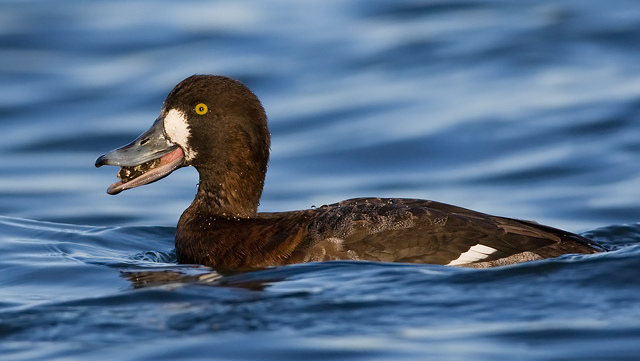
Broadbill rest and feed in large “rafts” – often with thousands of their kind. When feeding, the raft will drift down over feedbeds and so birds will regularly fly upwind from the tail of a raft up to its head. Rafting Broadbill can withstand rough seas – both while resting and feeding.
Individual feeding Broadbill frequently rear up and flap their wings – to rearrange and dry their flight feathers. This makes it easier to see the white wing stripe that extends from the inner (secondary) wing feathers to the outer (primary) wing feathers – the best way to separate Greater Scaup from Lessers in the field.
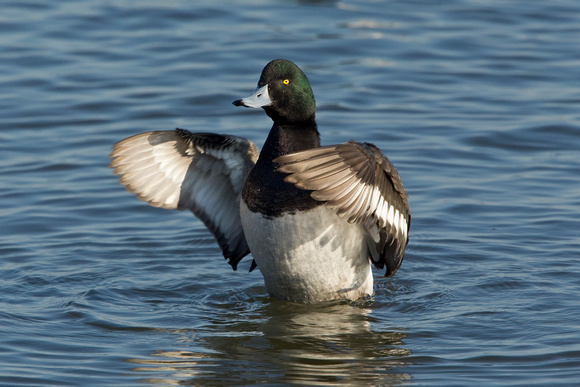
Broadbill fly fast – with a rapid wingbeat. Like other divers, they land quickly, splaying their feet – “flaps down” – to serve as brakes.
Broadbill populations on Great South Bay have declined dramatically since the late-twentieth century. Causes include contaminants in the Great Lakes that suppress reproduction in hens – but the principal cause is probably the degradation of water quality from human activities throughout Long Island.
HERTER’S MODEL 72 BROADBILL DECOY
~ a factory decoy that has stood the test of time
The Model 72 was first sold in the early 1950s. Jack Musgrove of Des Moines, Iowa was the designer/carver of the Model 72 – as well as many other Herter’s models from the 1940’s forward.
The early 72s had flat bottoms and brass screw eyes to hold the heads. Later birds had a keel molded into the body and used steel screws instead. All used cast iron for ballast molded into the body. More than one hunter has learned the hard way that styrofoam and outboard gas do not get along – completing dissolving the body if given the chance.
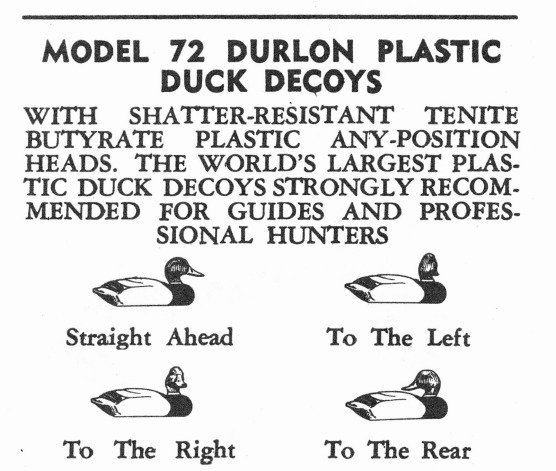
Thousands of Model 72 Broadbill are still in use today – often with a protective coating of epoxy or burlap and some fresh paint.
TWO BOATS or THREE ?
Some open bay rigs used just 2 boats but many used 3. Most of the old battery rigs had a big TENDER, a smaller STOOL BOAT and the battery itself. The battery was replaced by a SCOOTER (or two) when Broadbill was king.
The TENDER ~ The largest vessel was called by different names by different crews. Many called it the TENDER, but it was also called the base or the mother ship or simply the big boat. It served several purposes. First, it was the means of transportation from the dock to the gunning grounds. They were big cabin boats that could haul a lot of gear and also keep the crew warm and well-fed and out of the weather. The bigger vessels could stay out for days on end. Back in the day, they were powered by inboards and many had been converted from the days of sail – when a gaff rig and a centerboard was the way baymen got around Great South Bay.
The TENDER towed a STOOL BOAT and maybe a SCOOTER as well. Some TENDERS could haul their SCOOTER up on deck or hang it from davits on the stern – and thus avoid the dangers of towing a boat in heavy weather. Decoys could be stowed in the STOOL BOAT boat but could also be stowed on deck or – most likely – below decks in a hold.
Some TENDERS could handle ice and some could not. Earlier TENDERS had straight stems and could break through lighter ice IF their hulls had been sheathed in copper or oak. Some later boats sheathed their hulls with fibreglass above and below the waterline. The more recent TENDERS – built expressly for late-season gunning – had hulls that could get up on top of the ice and crush it. These hulls were usually built with heavy plywood sheathed with heavy ‘glass.
The STOOL BOAT – The next smaller vessel was known as the STOOL BOAT. It was an open hull that could be filled with decoys and was used to both set and pick up the rig – usually with a crew of two men. Earlier STOOL BOATS had small inboards but later boats used outboards. Once the rig was set, the stool boats were used to ferry gunners between the TENDER and the SCOOTER and also to retrieve downed birds.
Single-rigged decoys were stacked carefully in the earlier STOOL BOATS – so that the heavy anchor lines would not tangle. When some rigs moved to trawls – many decoys on a single line anchored fore and aft – they often built bins in the STOOL BOAT for each trawl.
The SCOOTER – The original SCOOTER was developed by Capt. Wilbur R. Corwin in Bellport Bay about 1874. Its purpose was to enable baymen – and later the Lifesaving Service and Coast Guard – to get around on a bay that was a patchwork of ice and open water. Its metal-shod runners allowed the SCOOTER to be pulled or piked or sailed over the ice. When encountering open water, it could “scoot” right across – propelled by pole or oars or canvas.
It was used for gunning early on and it quickly became popular further west, throughout Great South Bay. First used for gunning in “air holes” (aka “ice holes”) or along the bogs, SCOOTERS were soon adapted for gunning the open bay. When the battery was finally banned in 1935, SCOOTERS became the principal way of hiding in the middle of Great South Bay. The chines got lower and the crown got higher and the so-called “whaleback” SCOOTER was born.
Although true SCOOTERS are built plank-on-frame with rounded bilges and curves everywhere, other types were made and used for the same purpose. The advent of plywood – especially after WW II – led to the building of simpler, hard-chined vessels – more properly called skiffs or sharpies or flatties. And, SCOOTERS were built either for one gunner (SINGLE) or two (DOUBLE). Modern SCOOTERS are built of ‘glass – and still provide one of the most thrilling experiences in duckshooting.
SEASONS & LIMITS when the Broadbill was King
In 1937, shortly after the Battery was replaced by the open bay Scooter, the seasons and limits still reflected the low waterfowl populations of the Dust Bowl days. The season opened on November 1 and closed on November 30. The Duck limit was 10. You could shoot 5 Geese but Brant was closed. Ducks Unlimited was founded this same year.
The season length grew back to 80 days by 1944 but was dropped back to 45 by 1946. The limit was now 7 Ducks + 2 Geese. The next 2 seasons, though, dropped all the way to just 23 days. In 1947 and 1948 the limit was 4 Ducks.
In 1953, Long Island got its own zone and so its own season dates. It ran for 60 days from November 6 through January 4. The following year the limit was 4 Ducks + 4 Bonus Scaup (Broadbill). The Great South Bay Waterfowlers Association – now South Shore Waterfowlers – was founded.
Days came and went, as did the bag limit and the Scaup Bonus. In 1965, for example, there was a split season – October 16 – October 30 and Dec 10 – Jan 8 (50 days) . The limit was 3 Ducks but an additional 2 Scaup could be taken after November 15.
The first Special Scaup Season was allowed in 1967. The regular season ran from November 4 through December 23 – still at 3 Ducks per day. It was followed immediately – December 24 through January 7 – with the 16-day Special Season. Only Scaup could be taken but the limit was 5 birds per day.
E. ALLEN DECOYs ~ Today’s best factory birds?
E. ALLEN DECOYS are named after Eugene Allen Chandler – a longtime friend and business partner of Lou Tisch. They have manufactured and sold duckboats and decoys since the early 1980s. Lou now sells these high-quality, high-density urethane foam decoys out of Clinton Township, Michigan through www.lockstockbarrell.com.
Masters for all of their decoys are from “best in show” birds – carved by some of the best carvers in the country. Their Broadbill (Bluebill) are molded from birds carved by two gentlemen with strong ties to Long Island. Capt. Fred Muhs of Hampton Bays carved the master for the Standard Scaup and Keith Mueller – from Connecticut – carved the master for the Giant Scaup. Both were regulars at the U. S. National Decoy Show until its last year in 1994. Some other carvers for E. Allen Decoys include Paul Dobrosky, Del Herbert, Gary Hanson, Tim Bombardier, Hank Garvey and Bud Shell.
E. Allen Decoys are available as fully-painted birds or in “kit form” – where the heads and keels must be installed and the birds painted by the buyer.
Red Oster has used both the Standards and the Giants – moving toward the latter in recent years. On his Standard birds, he installed keels made from Trex deck material. Because Trex is so dense, he did not need to add extra ballast. The keels on his Giants are made from Spanish Cedar with lead ballast poured in. Red found it necessary, too, to open the keel up inside the body to reduce the drag in a strong current. Red uses PL Premium for an adhesive on both the heads and the keels.
Red trawls most of his decoys and so bores holes in both ends of the keel. The “mother line” of the trawl is attached to each decoy with zip ties fore and aft. A tug on the stern anchor line rights all of the birds at once.
OUR VIDEOGRAPHER EXTRAORDINAIRE ~ Anthony Bach from Amityville
Our historical documentary When the Broadbill was King on Great South Bay would not have been possible without the talents and energies of our videographer. Anthony is a student at the University of Maryland – and is studying for finals there today. He somehow finds the time to produce videos as www.island-outdoors.com. Over his Christmas break he spent a morning with us filming a Broadbill hunt with Red Oster and then a couple of afternoons and evenings with our “movie stars”.
Anthony has all manner of video equipment and uses it to good effect. As you can see in the film, he is a very quick study and made great use of our still images as he blended them into his footage during the editing process. We appreciate his professionalism and are certain you will, too.
HOW MUCH ICE CAN SHE BREAK?
That is not an easy question to answer because any significant thickness of salt water ice on the Bay usually forms over weeks of time. It can be converted to harder ice by the freshwater snow and rain. That being said, the RETRIEVER has run through salt ice 8 inches thick and even pushed through a pressure ridge 18 inches thick. The ridge took maximum power and at one point it seemed the engine might jump off its mounts as it launched ice chunks into the air. By its nature, salt ice is relatively soft and can be handled by a stainless steel wheel (prop). Freshwater ice is a different story.
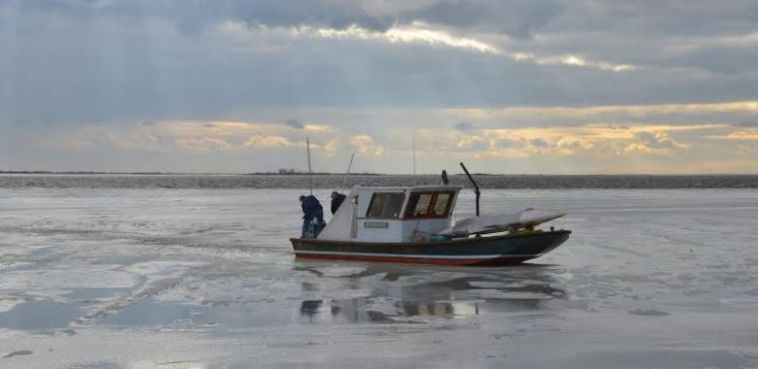
Late in January of 2015 the farm canal was locked in with ice that was mostly fresh. The RETRIEVER broke the half-mile of 4-6 inch ice with little difficulty. After that, she ran west of the Bridge through about 1.5 miles of 2-4 inch ice, again without strain. We reached open water off Babylon and ran over to Schuyler Watt’s canal. The canal had about 200 feet of old ice covering the entrance. We did not like the look of the ice but – since it was only 200 feet – we pushed ahead. One-hundred feet in the RETRIEVER was stopped – suspended by the ice. The ice had multiple layers of freshwater ice 8 inches thick. Headway was stopped when the motor came up against the unbroken plates of ice under the hull. After two long hours of hard chopping – motoring ahead a foot at a time – we arrived at Schuyler’s dock. The RETRIEVER was fine but the crew were somewhat worse for the wear. ~ by Brandt Rising
The Big Rigs
On our main display panel, we posted 49 rigs on an enlarged bay chart of Great South Bay. From West Islip “up west” to Patchogue “out east”, we printed the names of rig owners on boat-shaped cards – somewhat close to their home ports. We had so many rigs that the upland portion of the chart got a bit crowded. And, I am sure we missed a few.
We also “featured” a dozen of the rigs with more detailed information. In most cases we were able to find a photo of the tender and we had some good stories to tell. Here they are – more or less from west to east.
SCHUYLER WATTS ~ WEST ISLIP ~ The TOBY
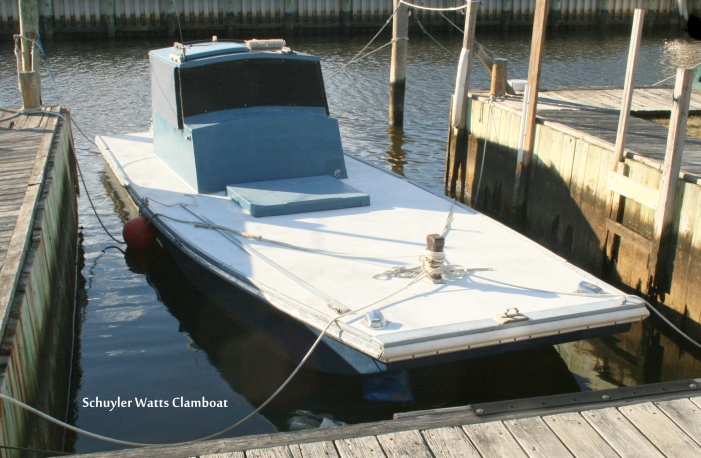
Schuyler Watts used a big clamboat – with wide flats decks designed for tonging – as the big boat. She was built by Mike Harwood in 1976. Schuyler named her TOBY – after his Dad’s old plumb-stemmed bay boat from the early part of the 20th century. He towed a 16-foot Amesbury Skiff to serve as the Stool Boat and shot from an original Dodge & Krowl single Scooter. The decoys – Herter’s Model 72s in later years – were rigged on 4 trawls, 2 long and 2 short.
LANDON K. THORNE ~ BAY SHORE ~ The GUSSUM
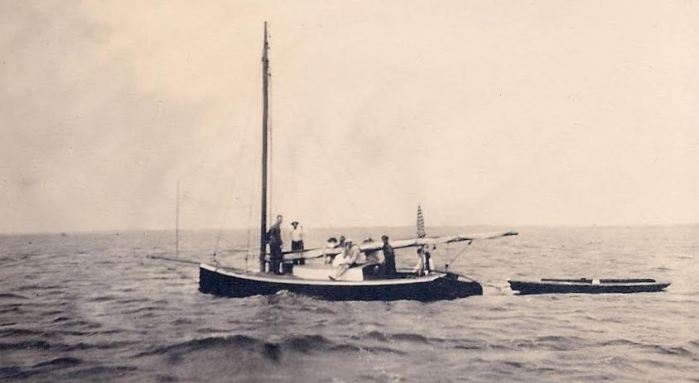
Several generations of Thornes hunted Great South Bay out of Bay Shore – beginning with the battery era. The catboat above is not the GUSSUM – sailed later by Landon – but belonged to his grandfather Edwin. The skiff towed here was used for gunning in the colder months. It would be covered with salt hay for use along the shore or draped with oiled gray canvas tarps for open water. The canvas covered the boat and floated out past the hull to work like a Scooter and looked like some floating ice. Actual Scooters, too, were towed out with this big cat.
HARRISON WATTS ~ BAY SHORE ~ The GROWLER
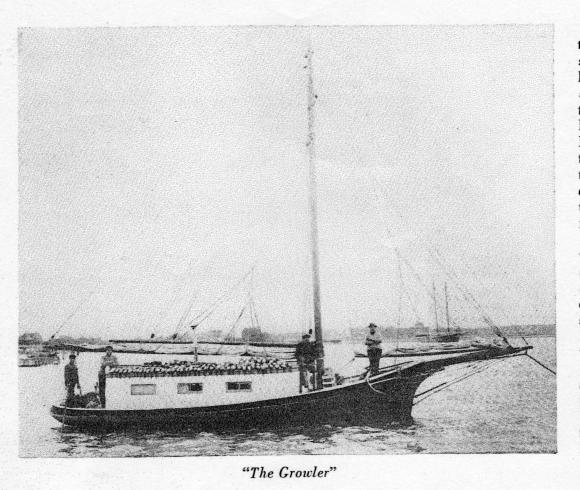
Captain Harrison Watts sailed the gaff sloop GROWLER throughout the market gunning era. A hunt with Harrison and the GROWLER in the 1950s was described in an article in The Conservationist:
“The eel grass disappeared in 1930 from the Bay. Redhead left it, perhaps forever. Brant became so scarce it was hardly worth the trouble. Only Broadbill remained faithful in any numbers…..”
Came WW II and most of the great rigs disappeared. The market hunter died off, one after another. Some few wealthy men who could afford the cost of hundreds of decoys, a “white boat” and a Bay boat, continued to rig on a crisp November morning. But more of them gave up, said gunning was through, and sold their decoys to an antique shop.”
BRANDT RISING ~ BAY SHORE ~ The RETRIEVER
The RETRIEVER was the brainchild of Bud Ladman and Todd Corsa. The 28-footer was built in 1978 – perhaps by Brud Skidmore at East Islip Lumber. They wanted a boat that was good in the ice with no concern for winterizing the engine – and so was outboard-powered – with a 175 Johnson. They wanted a two-man operation and so chose a Mother Boat and Scooter combination with no need for a stool boat. The Scooter was secured in chocks over the deck hatch and was launched with a steel davit hoist.
The original rig consisted of 100 Broadbill decoys hung from trawl poles. Each decoy was attached to the trawl line at only one point (the head) resulting in a string of 10 decoys which, when hung off an anchored trawl pole, would feather into the wind regardless of the effect of the wind and tide on the trawl. Brandt Rising and Bob Ferguson bought the RETRIEVER and rig from Bud in 1983.
HUNT HOWELL ~ EAST ISLIP ~ The HOWLER
CHARLES HORAL ~ EAST ISLIP ~ The SKIP & AL
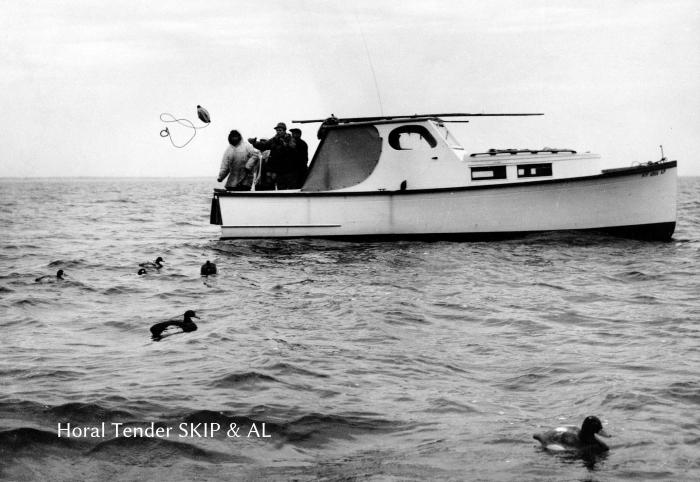
Charlie Horal owned the gas station in East Islip that was the gathering place for gunners and fisherman throughout the year. The SKIP & AL – named for his two sons – was a 1930s Richardson, about 30 feet LOA. Charlie removed the original cabin and built the one you see above – and also sheathed her hull with fibreglass above and below the waterline so she could make her way through ice up to 2 or so inches thick. A 2-man flattie – built by Brewster’s Shipyard in Bay Shore – was hauled over a roller he installed across the transom. When the gunning boat was afloat, they handed down a few 14-pound lead ingots to place under the stern deck to trim her. They did not use a Stool Boat but set and picked up the rig with the SKIP & AL. The 80 to 100 decoys were rigged as singles – and included a variety – from old cork root-heads to balsa Wildfowlers.
BRUD SKIDMORE ~ EAST ISLIP ~ The BROADBILL
Brud Skidmore owned East Islip Lumber and built a number of boats named BROADBILL in the shop there. This 30-footer was an inboard. He and Wally Willrick built a Stool Boat and a double Scooter for the rig and also made their decoys from “refrigerator cork” salvaged from an ice plant in Bay Shore. They also used a single Scooter – a plywood version of a Dodge & Krowl – built by Meritt Westbrook of Great River. Red Oster now owns the single. The Scooters were carried on deck and the rig was stowed below.
REMMER Family – OAKDALE ~ The HAPPY DAYS
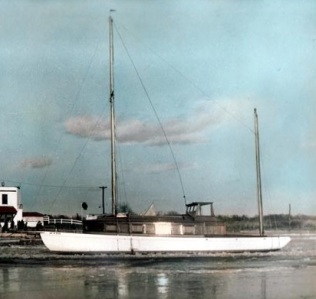
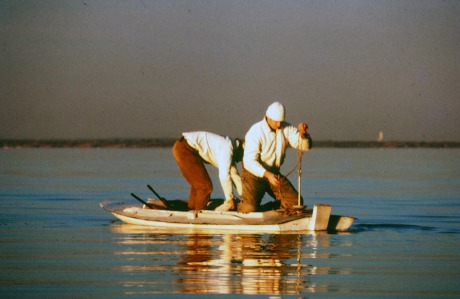
The Remmers used a 35-foot motorsailer for their big boat. The Happy Days was built by Wicks in Amityville circa 1883. She still sails during the warmer months.
They had a variety of Scooters – first wood, then glass. They frequently used the round-bottomed 2-man shown above. They would set 160 to 180 decoys that were a mix, including some by Len Tucker, some Masons and some Herters. When the Bay was frozen, they would hunt in airholes with their scooters – or simply sail for fun and sport. The Remmer family owns and operates the Snapper Inn right on the banks of the Connetquot River – on the Oakdale side.
RED OSTER ~ WEST SAYVILLE ~ The COMMANDING MISTRESS
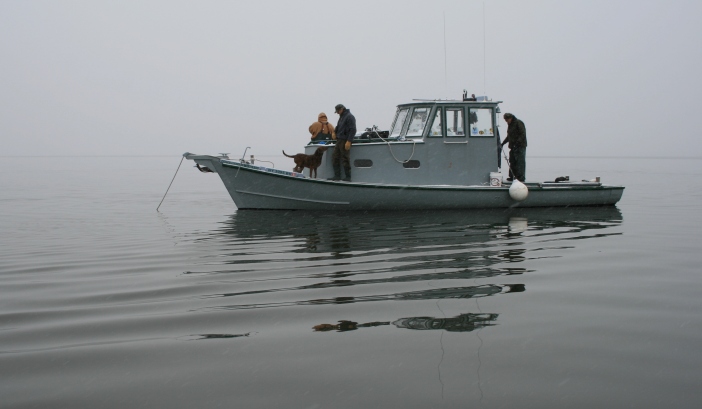
Since 1999, Red has guided parties as Redhead Guide Service and hunts from one end of Great South Bay to the other. COMMANDING MISTRESS was built in 1968 by Raymond Lofstad from Islip Terrace. Powered by a Chrysler 318 gasoline engine, she is 36-foot LOA with a 12-foot beam and draws 2 1/2 feet. Red and brother Steve haul a double Scooter on the stern deck and launch it over a roller on the the port side. A 14-foot Amesbury Dory – by Stur-Dee Boat Company – is towed behind and serves as the stool boat, with 4 compartments to stow the decoy trawls. Most of his 100-bird rig are oversize E. Allens – for which the master was carved by Keith Mueller.
SPIKE LAMBDIN ~ WEST SAYVILLE ~ The VIRGINIA LEE
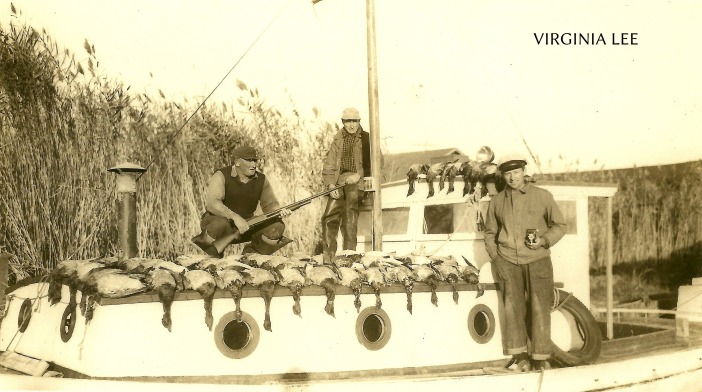
Like a couple of the others, Spike sailed duck shooting parties in winter and fishing parties in summer. Spike’s father owned a boatyard a little ways up Green’s Creek on the west side. – this is where he built the VIRGINIA LEE. Laid out a lot like the CHETOWAIK, she carried a double Scooter over the stern – fore and aft – and towed a big sharpie full of Broadbill, Brant and Black Duck stool.
JOHN VERBEKE, Sr. ~ WEST SAYVILLE ~ The CHETOWAIK
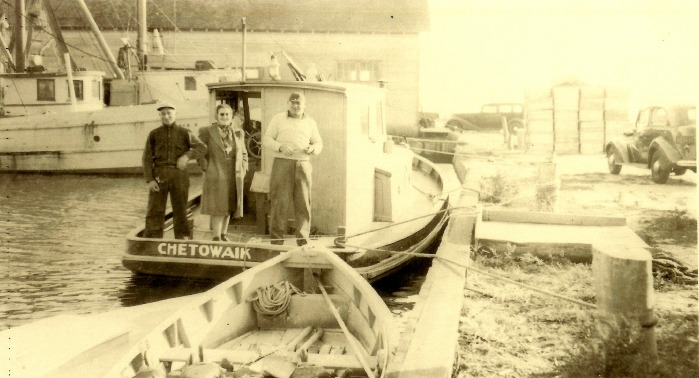
The CHETOWAIK was an old party boat that had a nice bowsprit, round stern, big cabin and pilothouse. She slept about four and had a head, a big oak drop-leaf table on gimbals, and a coal stove in the forward end of the cabin. She carried her double Scooter on a set of davits over the stern and towed a beautiful lapstrake Stool Boat with an inboard engine that carried 150 stool. He gunned parties with this same boat back in the days of the battery.
JOHN VERBEKE, Jr. ~ WEST SAYVILLE ~ The BLACK DUCK
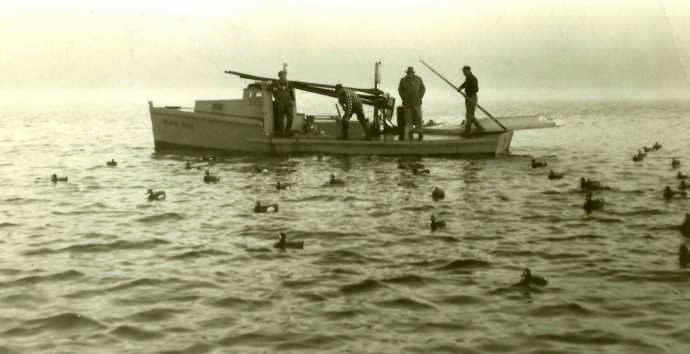
John Jr. started gunning on the Black Duck – his father’s boat – with his Dad and his Uncle Kep Verbeke. She was 35 feet long, 14 feet wide, tunnel stern, and drew 14 inches of water. She had a cabin forward and plenty of deck space. They carried 150 Broadbill stool down one hole and 50 Brant, 50 Black Duck, 30 Geese – and a few Goose and Brant tails – down the other. On the stern deck, they carried a two-man Scooter, which was real small and hid really well in smooth water. It also hid really well in the seaweed bunks on East Island when hunting Geese, Brant and Black Duck.
Hope to see you there – in 2016!

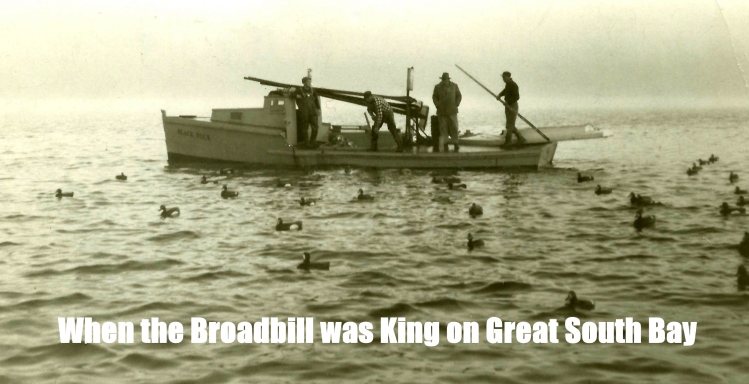
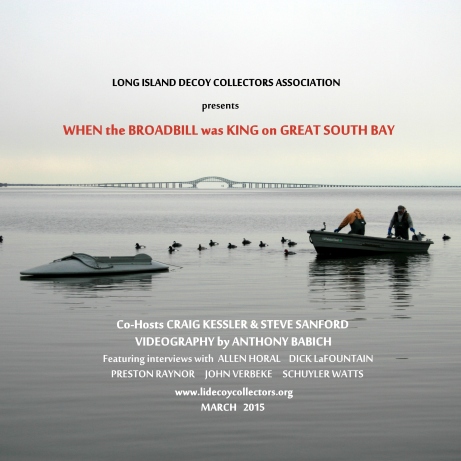
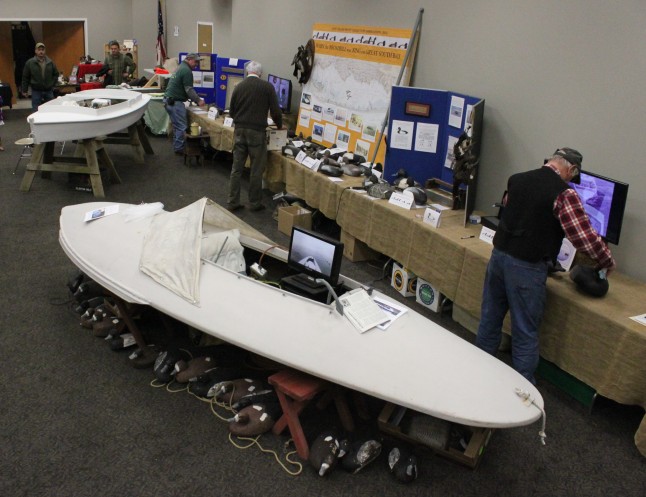
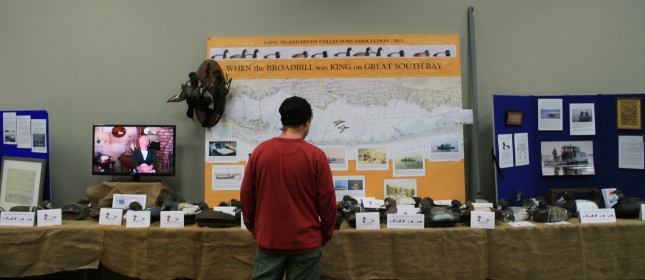
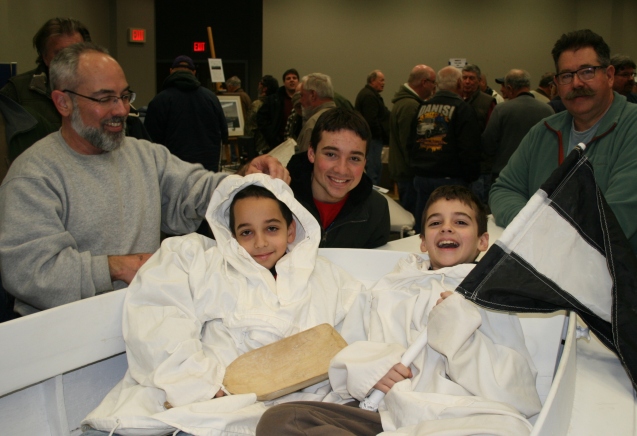
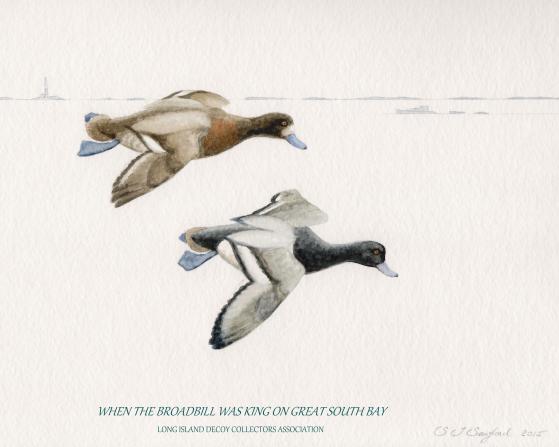
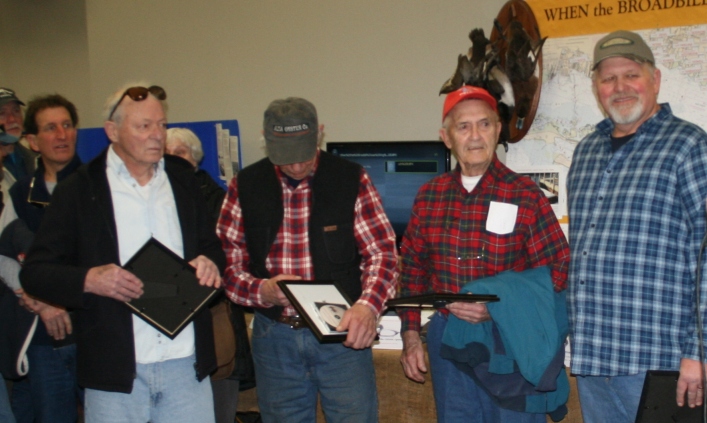
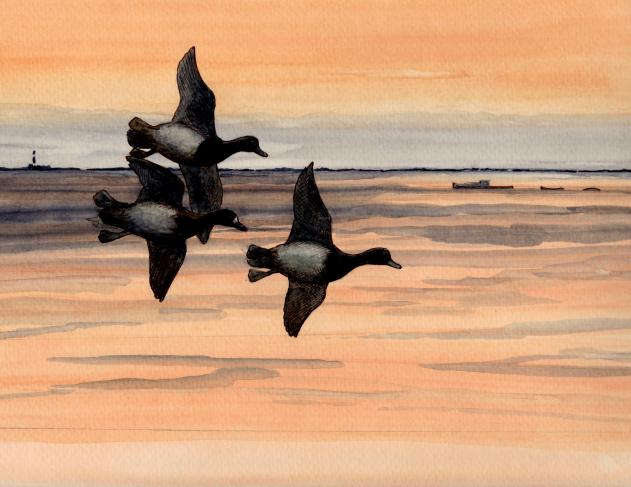
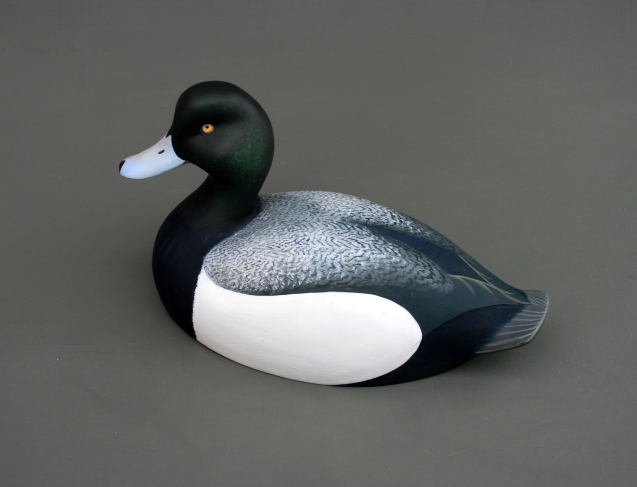
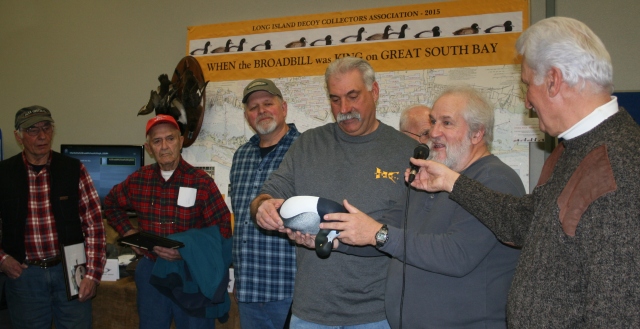
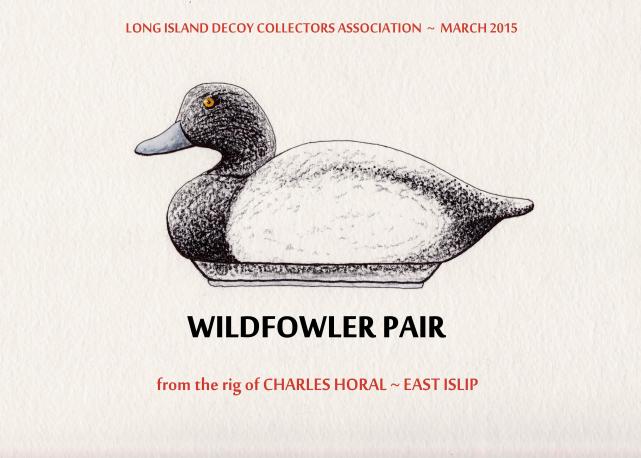

















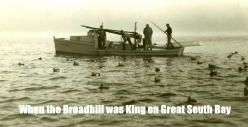

























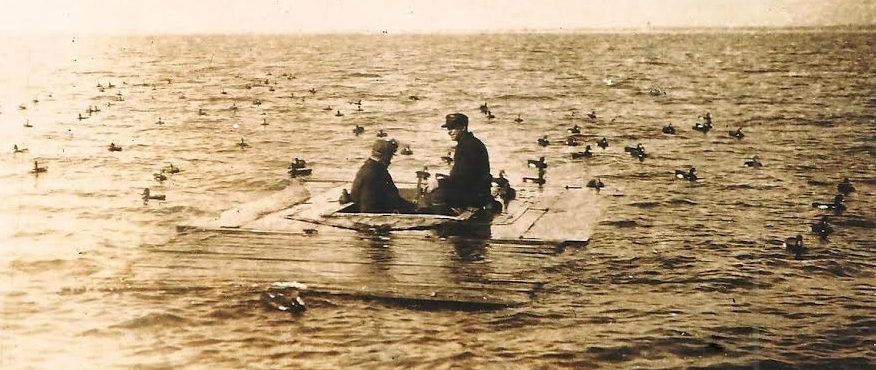
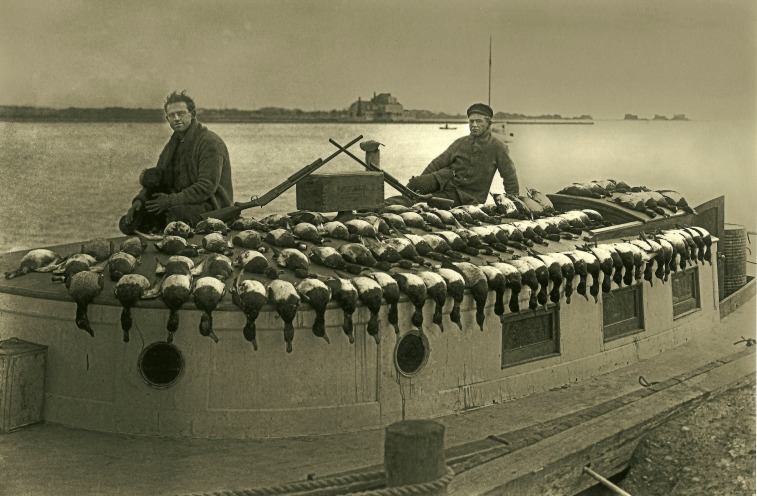
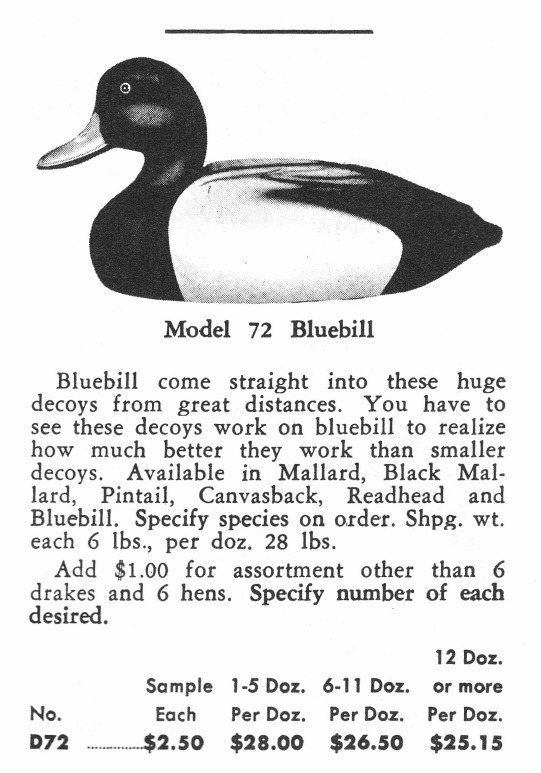
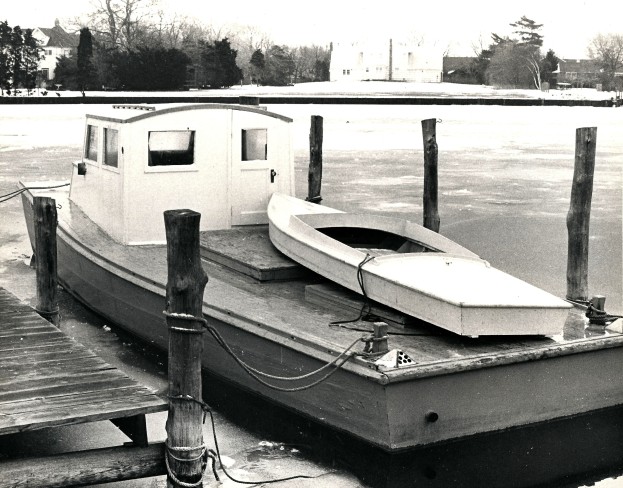
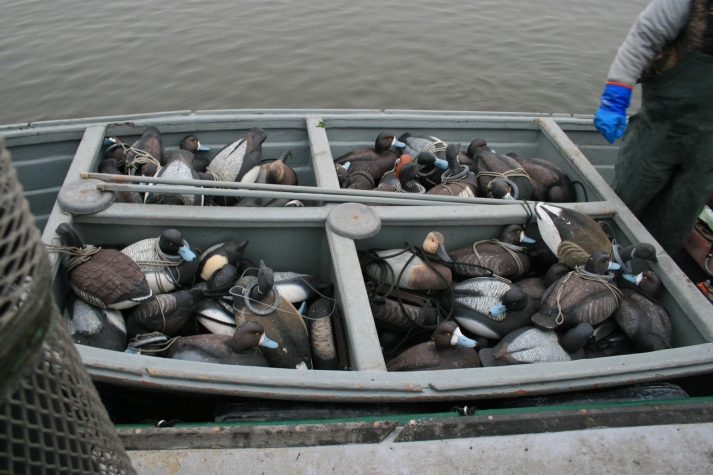
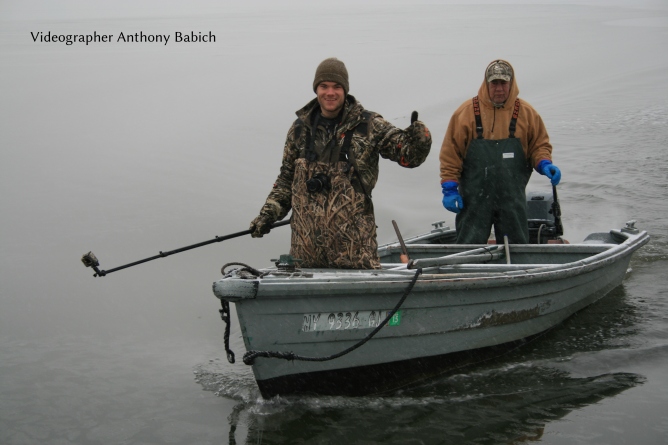
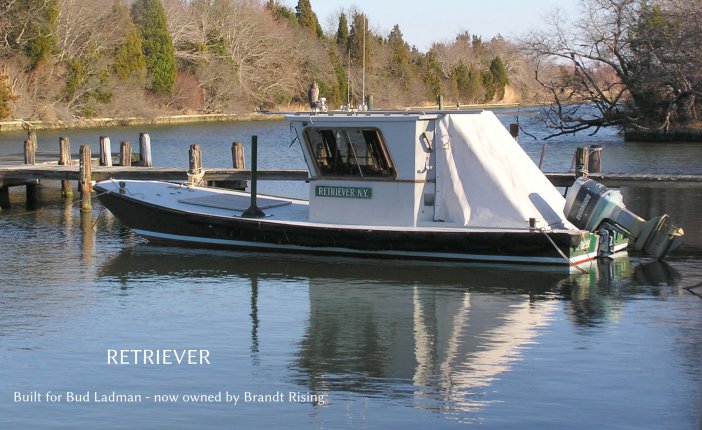
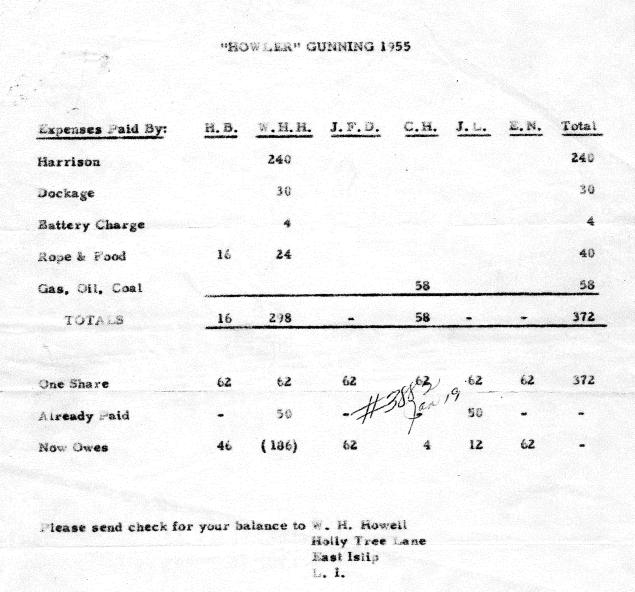
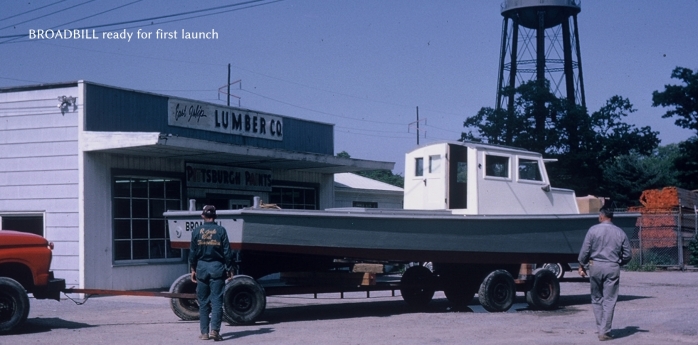

fantastic!!
Thank you for sharing. Any interior pictures of the Retriever?
Thank,s Steve.Found it very interesting.Hours and hours of research.
Enjoyed it all .Great old photos of a time that has long past but not forgotten.
What a great web site, brought so many memories, all my shooting was in the Hampton Bays/Flanders area. In my early years I was a guide with my dad(1952-59) for W.W. Hubbard at Hubbard’s meadows (now belonging to the county, I believe) I gunned with Fred Muhs and Buzzy Downs “scooter shooting” on Shinnecock bay. Where Broadbill was king also.. I was also fortunate, my wife Beverly was a good cook and no one could cook ducks like her.
Stumbled on your site while researching about my late father William Huntting Howell. Brought back many memories. Lived in SC for past 50 years but have his hunting logs and remember the days fondly.